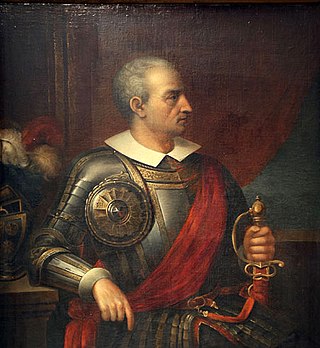
Diego de Almagro, also known as El Adelantado and El Viejo, was a Spanish conquistador known for his exploits in western South America. He participated with Francisco Pizarro in the Spanish conquest of Peru. While subduing the Inca Empire he laid the foundation for Quito and Trujillo as Spanish cities in present-day Ecuador and Peru, respectively. From Peru, Almagro led the first Spanish military expedition to central Chile. Back in Peru, a longstanding conflict with Pizarro over the control of the former Inca capital of Cuzco erupted into a civil war between the two bands of conquistadores. In the battle of Las Salinas in 1538, Almagro was defeated by the Pizarro brothers and months later he was executed.

Huáscar Inca also Guazcar was Sapa Inca of the Inca Empire from 1527 to 1532. He succeeded his father, Huayna Capac and his brother Ninan Cuyochi, both of whom died of smallpox during the same year while campaigning near Quito.

Atahualpa, also Atawallpa (Quechua), Atabalica, Atahuallpa, Atabalipa, was the last effective Inca emperor before his capture and execution during the Spanish conquest of the Inca Empire.

Huayna Capac was the third Sapa Inca of Tawantinsuyu, the Inca Empire. He was the son of and successor to Túpac Inca Yupanqui., the sixth Sapa Inca of the Hanan dynasty, and eleventh of the Inca civilization. He was born in Tumipampa and tutored to become Sapa Inca from a young age.
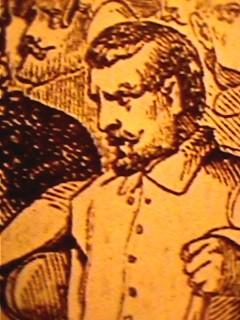
Gonzalo Pizarro y Alonso was a Spanish conquistador. He was the younger paternal half brother of Francisco Pizarro, who led the Spanish conquest of the Inca Empire. Pizarro was the illegitimate son of Gonzalo Pizarro y Rodríguez de Aguilar (1446–1522), who, as an infantry colonel, served under Gonzalo Fernández de Córdoba during the Italian Wars. He was also the younger paternal half brother of Hernándo Pizarro y de Vargas and the older paternal full brother of Juan Pizarro y Alonso.
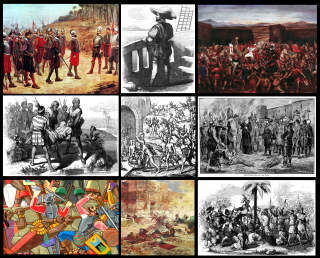
The Spanish conquest of the Inca Empire, also known as the Conquest of Peru, was one of the most important campaigns in the Spanish colonization of the Americas. After years of preliminary exploration and military skirmishes, 168 Spanish soldiers under conquistador Francisco Pizarro, along with his brothers in arms and their indigenous allies, captured the Sapa Inca Atahualpa in the 1532 Battle of Cajamarca. It was the first step in a long campaign that took decades of fighting but ended in Spanish victory in 1572 and colonization of the region as the Viceroyalty of Peru. The conquest of the Inca Empire, led to spin-off campaigns into present-day Chile and Colombia, as well as expeditions to the Amazon Basin and surrounding rainforest.

Manqu Inka Yupanki (Quechua) was the founder and monarch of the independent Neo-Inca State in Vilcabamba, although he was originally a puppet Inca Emperor installed by the Spaniards. He was also known as "Manco II" and "Manco Cápac II". He was one of the sons of Huayna Capac and a younger brother of Huascar.
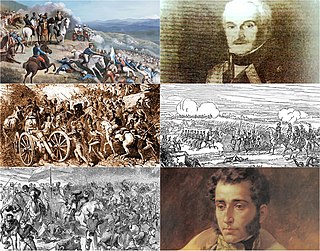
The Ecuadorian War of Independence, part of the Spanish American wars of independence of the early 19th century, was fought from 1809 to 1822 between Spain and several South American armies over control of the Real Audiencia of Quito, a Spanish colonial jurisdiction which later became the modern Republic of Ecuador. The war ended with the defeat of the Spanish forces at the Battle of Pichincha on May 24, 1822, which brought about the independence of all the lands of the Real Audiencia of Quito.
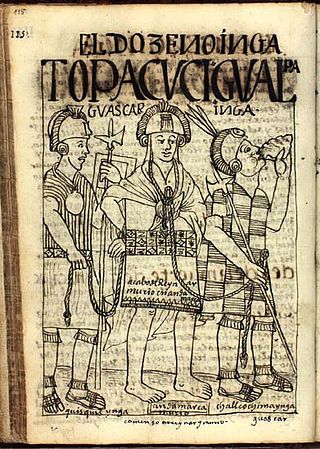
Quizquiz or Quisquis was, along with Chalcuchimac and Rumiñawi, one of Inca emperor Atahualpa's leading generals. In April 1532, along with his companions, Quizquiz led the armies of Atahualpa to victory in the battles of Mullihambato, Chimborazo and Quipaipan, where he, along with Chalkuchimac defeated and captured Huáscar and promptly killed his family, seizing capital Cuzco. Quizquiz later commanded Atahualpa's troops in the battles of Vilcaconga, Cuzco and Maraycalla (1534), ultimately being bested by the Spanish forces in both accounts.
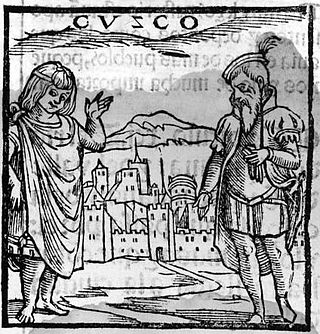
The Battle of Cusco was fought in November 1533 between the Spanish Conquistadors and of the Incas.
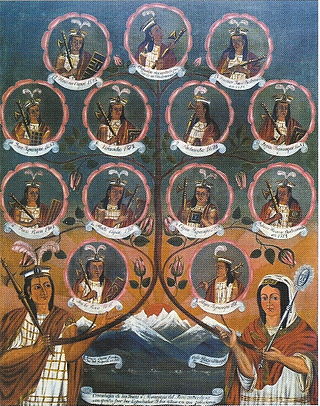
The Incas were most notable for establishing the Inca Empire which was centered in modern-day South America in Peru and Chile. It was about 4,000 kilometres (2,500 mi) from the northern to southern tip. The Inca Empire lasted from 1438 to 1533. It was the largest Empire in America throughout the Pre-Columbian era. The Inca state was known as the Kingdom of Cuzco before 1438. Over the course of the Inca Empire, the Inca used conquest and peaceful assimilation to incorporate the territory of modern-day Peru, followed by a large portion of western South America, into their empire, centered on the Andean mountain range. However, shortly after the Inca Civil War, the last Sapa Inca (emperor) of the Inca Empire was captured and killed on the orders of the conquistador Francisco Pizarro, marking the beginning of Spanish rule. The remnants of the empire retreated to the remote jungles of Vilcabamba and established the small Neo-Inca State, which was conquered by the Spanish in 1572.
The Battle of Chimborazo was among the first confrontations in the War of the two brothers, a struggle between Huáscar and Atahualpa for power over the Inca Empire. Atahualpa won, having the more capable generals; he drove Huáscar back onto the defensive.
The Battle of Quipaipán was the decisive battle of the Inca Civil War between the brothers Atahualpa and Huáscar. After the victory at Chimborazo, Atahualpa stopped in Cajamarca as his generals followed Huáscar to the south. The second confrontation took place at Quipaipán, where Huáscar was again defeated, his army disbanded, Huáscar himself captured and - save for the intervention of Pizarro - the entire Inca empire nearly fallen to Atahualpa.
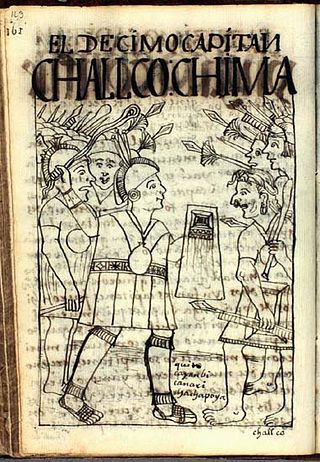
Chalcuchima was, along with Quizquiz and Rumiñawi one of the leading Inca generals of the north and a supporter of Atahualpa, for whom he had won five battles against the Spaniards.
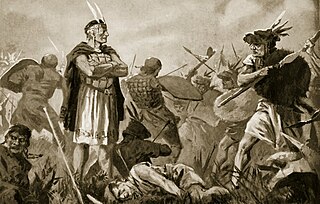
The Inca Civil War, also known as the Inca Dynastic War, the Inca War of Succession, or, sometimes, the War of the Two Brothers, was fought between half-brothers Huáscar and Atahualpa, sons of Huayna Capac, over succession to the throne of the Inca Empire. The war followed Huayna Capac's death.

The Inca army was the multi-ethnic armed forces used by the Tawantin Suyu to expand its empire and defend the sovereignty of the Sapa Inca in its territory.
The Battle of Vilcaconga took place during the Spanish conquest of the Inca Empire from November 8–9, 1533. The Spanish won a convincing victory, suffering minimal casualties.
The Battle of Huanucopampa was a 1532 battle in the Inca Civil War.
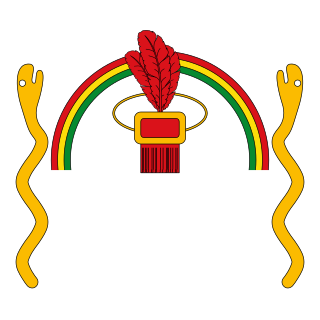
The Neo-Inca State, also known as the Neo-Inca state of Vilcabamba, was the Inca state established in 1537 at Vilcabamba by Manco Inca Yupanqui. It is considered a rump state of the Inca Empire (1438–1533), which collapsed after the Spanish conquest in the mid-1530s. The Neo-Inca State lasted until 1572, when the last Inca stronghold was conquered, and the last ruler, Túpac Amaru, was captured and executed, thus ending the political authority of the Inca state.

Ecuador–Spain relations are the current and historical relations between Ecuador and Spain. Both nations are members of the Association of Academies of the Spanish Language and the Organization of Ibero-American States.















